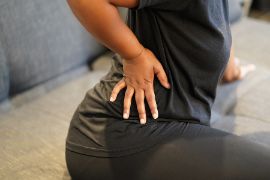Low back pain is a common occurrence for a large number of adults and sometimes it’s accompanied by hip pain. There are several underlying causes of persistent pain in these areas and in a number of cases issues related to the pelvic floor are overlooked.
The pelvic floor is made up of tendons, ligaments, and muscles that are attached to the bottom of the pelvis and extend along the front of the pubic bone, around the sides of the hip bones, and to the lower back where the tailbone is located.
 Additional muscles that are attached to the tailbone and pelvis include vaginal, anal, abdominal, gluteal (buttocks), and hip muscles. This means that issues affecting the pelvic muscles can cause problems for other areas of the body such as the lower back and hips. More specifically, when muscles or ligaments in the pelvis become weak, too tight, or damaged this can lead to a condition known as pelvic floor dysfunction. This condition is generally more prevalent in women than men and people affected by it may experience a number of symptoms that include:
Additional muscles that are attached to the tailbone and pelvis include vaginal, anal, abdominal, gluteal (buttocks), and hip muscles. This means that issues affecting the pelvic muscles can cause problems for other areas of the body such as the lower back and hips. More specifically, when muscles or ligaments in the pelvis become weak, too tight, or damaged this can lead to a condition known as pelvic floor dysfunction. This condition is generally more prevalent in women than men and people affected by it may experience a number of symptoms that include:
- Pelvic pain including genital pain
- Lower back and/or hip pain
- Bladder and/or bowel leakage
- The urge to urinate frequently
- Trouble emptying the bowels or bladder completely
- Pelvic organ prolapse (tissue that bulges out of the vagina or anus)
Physical therapy is a beneficial approach for managing symptoms related to pelvic floor dysfunction. Physical therapy for this condition would entail relaxing and lengthening pelvic floor muscles if they are short or tense, as well as strengthening muscles in this region if they are weak.
People can have weak and short, or long and tight muscles, or any combination therein, and the best way to determine their actual status is to be assessed with an exam by a pelvic health physical therapist. In addition to improving pelvic floor dysfunction, physiotherapy can also target issues that are associated with it such as pelvic pain, urinary incontinence, frequent urination, painful urination, and problematic bowel movements, among others.
Specific techniques that may be used to normalize the muscles and tendons in the pelvic floor include: breath work, deep tissue massage (myofascial release), skin rolling, trigger point therapy, joint mobilization, electrical stimulation, therapeutic ultrasound, and nerve release. Certain exercises such as squats, bridges, and Kegels may also be recommended, along with biofeedback training which involves being connected to electrical sensors that record signals from your body, in order to help you implement changes (e.g., posture, body movements) that will address your pelvic issues.
If you’ve been dealing with chronic back and hip pain and conventional treatments have not given you full relief, it may be time to speak with a physical therapist who can perform a thorough assessment that often includes a direct evaluation of your pelvic floor via vaginal or anal exam.
If pelvic floor dysfunction is contributing to your discomfort, a physical therapy regimen that is specifically designed for you can help ensure that the underlying cause of your chronic pain is properly addressed. The physical therapists at Iron City Physical Therapy have years of experience with different pain management approaches, and they are sensitive to the needs of each individual they work with. Call today to schedule your consultation.
References
1. Faubion SS, Shuster LT, Bharuchac AE. Recognition and Management of Nonrelaxing Pelvic Floor Dysfunction. Mayo Clin Proc. 2012;87(2):187-193.
2. Nygaard I, Barber MD, Burgio KL, et al. Pelvic Floor Disorders Network Prevalence of symptomatic pelvic floor disorders in US women. JAMA. 2008;300(11):1311-1316.
3. Haylen BT, de Ridder D, Freeman RM, International Urogynecological Association; International Continence Society An International Urogynecological Association (IUGA)/International Continence Society (ICS) joint report on the terminology for female pelvic floor dysfunction. Neurourol Urodyn. 2010;29(1):4-20.
4. Rosenbaum T.Y, Owens A. The role of pelvic floor physical therapy in the treatment of pelvic and genital pain-related sexual dysfunction (CME). J Sex Med. 2008;5(3):513-523.
5. FitzGerald M.P., Kotarinos R. Rehabilitation of the short pelvic floor, II: treatment of the patient with the short pelvic floor. Int Urogynecol J Pelvic Floor Dysfunct. 2003;14(4):269-275.
5. Chokshi T, Alaparthi GK, et al. Practice patterns of physiotherapists in neonatal intensive care units: A national survey. Indian J Crit Care Med. 2013;17(6):359-366.




